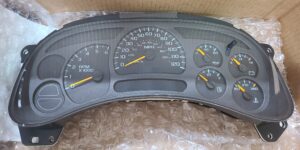Discover Top Techniques for Effective Car Instrument Collection Repair and Upkeep
In the realm of vehicle maintenance, the elaborate system of a tool cluster plays an essential function in offering motorists with crucial info concerning their car's efficiency. When confronted with problems associated to this essential part, having a thorough understanding of reliable repair work and maintenance methods is extremely important. From identifying common cluster malfunctions to utilizing specialized tools for precision fixings, a systematic approach can guarantee ideal functionality and long life of this essential dashboard feature. Stay tuned to uncover the leading techniques that can enhance the procedure of car instrument collection repair service and upkeep, inevitably boosting your driving experience and automobile performance.
Typical Instrument Cluster Issues
Some common issues might emerge with lorry instrument clusters, influencing their functionality and precision. One common trouble is a malfunctioning speedometer, which can cause security issues and prospective legal issues otherwise dealt with quickly. This concern often originates from a defective rate sensor or damaged electrical wiring, triggering imprecise speed analyses or full failing of the speedometer. One more regular problem is a non-responsive fuel scale, resulting in unpredictability concerning fuel levels and possible unanticipated failures. This problem can be caused by a faulty gas level sensing unit or a malfunctioning gauge collection. Additionally, flickering or dark control panel lights are common problems among car proprietors. This issue might be associated to loosened links, a failing dimmer switch, or damaged bulbs. These troubles can prevent the driver's capability to keep an eye on crucial automobile details, emphasizing the significance of prompt tool cluster repair and maintenance to make sure optimal functionality and precision while driving.
Vital Devices for Repair
When attending to common tool cluster concerns such as malfunctioning speedometers, unresponsive gas assesses, or dark dashboard lights, having the essential tools for fixing is essential in ensuring exact and reliable diagnostics and upkeep. Among the primary devices required for vehicle instrument collection fixing are an electronic multimeter for testing voltage and resistance degrees, a welding torch for dealing with loose connections or defective components, and a set of screwdrivers for taking apart the collection. Additionally, specialized tools like collection removal hooks may be required for securely removing the cluster from the control panel.

Analysis Techniques for Repairing
Utilizing advanced analysis techniques is important in efficiently fixing issues within vehicle tool clusters to pinpoint and resolve underlying problems properly. When faced with a malfunctioning instrument collection, service technicians typically rely upon diagnostic devices like multimeters, check devices, and specialized software to determine the source of the issue. These tools make it possible for professionals to access the cluster's inner systems, obtain mistake codes, and execute system examinations to detect issues efficiently. Furthermore, strategies such as circuit screening, voltage checks, and signal analysis play a critical function in detecting intricate digital mistakes within the tool collection. By following methodical diagnostic treatments and analyzing analysis outcomes properly, specialists can enhance the troubleshooting process and guarantee the appropriate functioning of the tool cluster. Regular training and remaining upgraded on the current analysis modern technologies are vital for professionals to successfully fix modern tool collections with advanced attributes. A thorough diagnostic strategy not only conserves time however additionally promotes precision in recognizing and fixing instrument collection issues immediately.
Cleaning and Maintenance Tips

Software Program Updates and Calibration

Calibration is another essential aspect of preserving your car tool cluster. This process involves readjusting the setups and parameters within the software to guarantee that the displayed info, such as speed, gas degree, and temperature, is trustworthy and precise. Correct calibration not only enhances the customer experience but likewise adds to security when driving by providing motorists with reliable and precise information.
To ensure that your auto instrument collection operates ideally, it is advised to adhere to the producer's guidelines relating to software program updates and calibration periods. By staying aggressive in these areas, you can make the most of the effectiveness and life expectancy of your instrument cluster.
Conclusion
To conclude, reliable auto tool cluster repair service and upkeep call for a comprehensive understanding like it of typical issues, essential devices, analysis strategies, cleaning up approaches, and software program updates. By utilizing these techniques, service technicians can efficiently deal with and repair instrument cluster problems, ensuring exact and reputable efficiency of the automobile's dashboard screen. Normal maintenance and calibration are crucial to avoid future concerns and guaranteeing the proper performance of the instrument collection.
When dealing with common tool cluster problems such as malfunctioning speedometers, unresponsive gas assesses, or dark dashboard lights, having the necessary tools for repair is important in ensuring reliable and exact diagnostics and upkeep. Among the primary devices needed for auto tool collection repair service are an electronic multimeter for testing voltage and resistance levels, a soldering iron for dealing with loose connections or damaged components, and a collection of screwdrivers for dismantling the collection. Furthermore, specialized devices like cluster removal hooks may be necessary for safely separating the collection from the control panel.
In conclusion, efficient automobile instrument cluster repair work and more tips here maintenance need a comprehensive understanding of common problems, crucial devices, analysis techniques, cleaning up techniques, and software application updates. Regular maintenance and calibration are vital to protecting against future concerns and guaranteeing the proper functioning of the instrument collection.